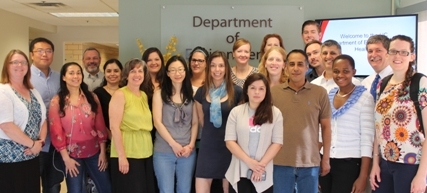With generous support from the Society of Toxicology (SOT) Supplemental Training for Education Program (STEP), I was able to attend the Toxicology Excellence for Risk Assessment (TERA) Dose-Response Boot Camp in June 2015 in Cincinnati, Ohio, at the University of Cincinnati. This was a week-long intensive course that provided hands-on training in hazard characterization and dose-response assessment with a primary focus on human health risk assessment. Miao Li also attended this course and wrote a blog on his experience.

SOT STEP Recipients Miao Li pictured second from the left and Eric Ditzel pictured in the far right of the top row.
As my graduate career draws to a close, I am interested in pursuing a career in human health risk assessment, and this course provided a great opportunity to gain the insight and hands-on experience I needed. Outside of on-the-job training, continuing education courses, and self-teaching, there are few ways to become proficient in risk assessment, so this well-regarded course was a great way to prepare myself for my desired career path. As I have been pursing career opportunities, this course has given me a strong foundation in human health risk assessment that will make my transition to a new career smoother. This training will allow me to distinguish myself for such opportunities as well as to participate in more professional development in risk assessment now that I have the necessary working knowledge.
The course introduced the concept of utilizing a mode-of-action approach to both cancer and non-cancer risk assessment during the hazard characterization process and detailed steps necessary to determine adverse effects, critical studies, and human relevance. We also were given in-depth training on dosimetric adjustment for human inhalation and oral exposure during dose-response assessment. In addition, we learned how to perform Benchmark Dose Modeling (BMD), how to incorporate the models into risk assessments, and how to determine point of departure. Finally, we were introduced to approaches for determining uncertainty factors (for multiple applications and agencies) including how to utilize Chemical Specific Adjustment Factor (CSAF) methods. We also were made familiar with some of the more cutting-edge strategies in risk assessment including physiologically-based pharmacokinetic (PBPK) modeling and combined exposures.
The primary instructor was Dr. Andrew Maier. The course had a lecture-type format that was very effective in creating an environment where questions and discussion were encouraged allowing everyone to become comfortable with the material. In addition to the lectures, another of the rewarding and beneficial aspects of the course was the ability to work in small groups to perform the various aspects of a risk assessment. As we learned about hazard characterization, dosimetry, BMD, and other areas, we were given opportunities to apply our knowledge and become more comfortable with the concepts by applying them to real world examples.
To bring all of these knowledge areas together, we were given the opportunity to prepare an entire risk assessment from the ground up as a group and then present and justify our work to the class over the course of the week. I cannot recommend this course highly enough for individuals seeking to enhance their knowledge of risk assessment, and I am very appreciative that the SOT STEP gave me the opportunity to participate.